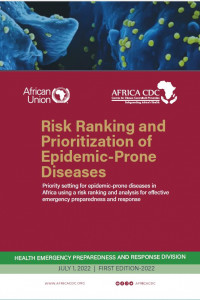
Risk Ranking and Prioritization of Epidemic-Prone Diseases
Response
Description
A. Background The International Health Regulations (IHR-2005) identify mapping and using priority health risks and resources as one of the core capacities in Public Health Emergency Preparedness and Response (PHEPR). Effective preparedness and swift response to epidemic is the goal of Africa Centres for Disease Control and Prevention (Africa CDC). In this regards, Africa CDC in collaboration with European Centre for Disease Prevention and Control (ECDC) set out to apply a methodology and tool to rank diseases and public health events requiring a rapid and efficient response under a multidisciplinary consultation forum. B. The methodology considered the changing context of the African continent where emerging and re-emerging diseases give rise to outbreaks with greater impact on communities. Priority setting must be placed in the broader context of public health emergency preparedness and response planning, through which risk assessment, decision-making, capacity building, resource allocation and response implementation, and evaluation represent some of the concrete and crucial stages of public health preparedness plans and of the related planning cycles. The identification and prioritization of risks will serve to define preparedness options and rationally allocate resources needed to reach emergency response objectives.Purpose and objectives 1. The purpose of prioritization/risk ranking of epidemic-prone disease is to inform Africa CDC strategic planning and help effective resource allocation to manage prevention/mitigation and response actions to health emergencies. This is a critical step for effective response to limit the spread of diseases, prevent/ minimize morbidity and mortality, social-and economic disruptions and, as well as early possible socio-economic recovery and returning to normal. Specifically, the objective for conducting risk ranking (RR) was to: 2. Rank infectious diseases of epidemic potential in order to identify the priority diseases for emergency preparedness and response. • To use the results of the RR in the broader context of the following: • Broder emergency preparedness planning, capacity building and resourcing; • Targeted prepositioning of essential medical and non-medical countermeasures; i.e., medical supplies, diagnostics, therapeutics and vaccines; and plan for logistics for emergency preparedness and response; • Liaise and work with other respective Divisions in Africa CDC and partners on development of essential diagnostic, therapeutic and vaccine lists needed for emergency response; C. Contribute towards research, development and innovation prioritization, in new and advanced technology and public health actions for prevention, early detection and rapid response; including pathogen-genomic surveillance expansion in Africa.
